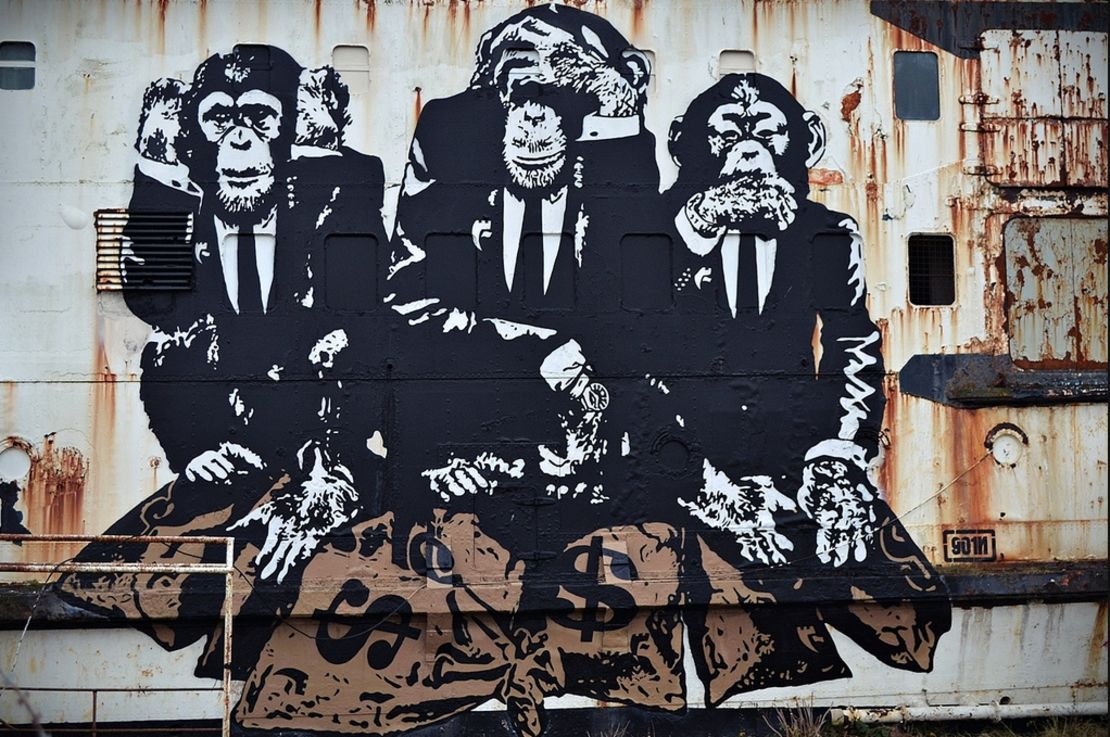Editor’s Note: MainSail is CNN’s monthly sailing show, exploring the sport of sailing, luxury travel and the latest in design and technology.
Story highlights
Grounded ship, Duke of Lancaster, attracts graffiti artists from across world
The ship has a rich history, from passenger ferry to beached Funship
The vessel was left to decay until arts collective DuDug set to work
Campaign to turn ship into centerpiece of arts festival
Three monkeys dressed in suits crouch on bulging sacks of money, striking the symbolic pose of “hear no evil, see no evil, speak no evil.”
At more than 10-meters tall, the imposing chimps are the size of a three-storey building, dwarfing onlookers gazing up at their grim, spray-painted faces.
The menacing monkeys are joined on all sides by similarly fantastical and macabre creatures – from skeleton divers to slobbering pigs – and you get the feeling that out here, in the desolate British marshlands, no one would hear you scream were they to come alive.

Welcome to the Duke of Lancaster. A hulking, rusting, abandoned ship on the Dee Estuary in north Wales, which has become a canvas for some of the most renowned graffiti artists from across Europe.
Read related: Ghostly underwater art gallery breathes new life to sunken ship
“It’s got the potential to be the biggest open-air art project in the world,” ship co-ordinator, Paul Williams, said.
“The quality and size of the pieces is spectacular – there aren’t many places in the world that can accommodate artworks 10-meters high.”
Work of art
At a whopping 137-meters long, seven storeys tall, and weighing 4,500-tons, the former cruise liner is an awe-inspiring sight in the deserted countryside.
It was this remarkable setting which prompted graffiti collective DuDug – a word play on the Welsh for “black duke” – to approach the ship’s owners with the innovative idea of turning the abandoned vessel into a thriving arts destination.
With the owners’ approval, artists from across Europe began spray painting the decrepit ship, using cherry pickers – a type of hydraulic aerial work platform – to reach its towering walls.
They are now campaigning to have the site reopened to the public as the centerpiece of an arts festival.
“When the pieces first started appearing, we had some people say ‘that’s no way to treat the ship.’” Williams said.
“But there’s no doubt that what they’re doing is art – the key definition between art and graffiti is graffiti is done illegally. This, however, is done with the owner’s knowledge and accommodation.
“And if it’s the catalyst for regeneration, it’s got to be a good thing,” added Williams.
More from Mainsail: World’s top five ‘boatels’
Vibrant vessel
The surreal artworks of punk geishas and bandit businessmen have an anarchist aesthetic inspired by the history of the ship – particularly the owners’ struggle with the local council to keep it open.
The largest of these pieces is “Eduk the Diver” – a skeleton in a retro deep-sea diving suit – which is 18-meters tall and 14-meters wide.
Hailing from across Europe, the top graffiti artists include France’s GOIN, who created the impressive Council of Monkeys image, and Latvian KIWIE who painted the creepy pirates on the ship’s bow.
“The first phase of artists chose the theme of corruption to work with and their artworks certainly portrayed this,” Dudug co-ordinator, Maurice Blunt, said.
“I can see no better way to bring the historical plight of this beautiful old lady to the world other than creating a true landmark – the largest open air gallery in Europe.”
From ferry to funship
It’s the latest reincarnation for a ship which began life as a British passenger ferry in 1956.
Built in the same shipyard in Belfast as the Titanic, the Duke boasted an opulent interior, silver service restaurant and spacious cabins.
“She was one of the finest vessels afloat at the time,” Williams said of the ship, which also operated as a luxury cruise liner during the summer months.
In 1970 the Duke was converted into a car ferry and by 1978 she was destined for the scrap yard when four entrepreneurs bought her in the hope of turning her into a land-based leisure and retail complex.
And so in 1979 the Funship, as she was known, was permanently beached on the banks of the Dee Esturay and equipped with a mall, cinema, game arcade, restaurant, nightclub and hotel rooms.
Eerie inspiration
But the fun times would be short lived. The council withdrew support for the ship due to safety concerns, and it closed in 1985.
“After many years of long-running disputes with the council, the owners decided to lock the doors, walk away and concentrate on other business ventures,” Williams said. “John Rowley (one of the owners) always wanted to see the ship have a purposeful use and has continued to fight tirelessly to make that happen.
“Inside, it’s like a time capsule. Other than some minor vandalism, it’s immaculate.”
The untouched interior adds a ghostly quality to the historic ship, which cuts an impressive figure on the deserted quay.
“It’s a very eerie place,” Williams said. “But that’s part of the reason why it captures people’s imaginations.”
















